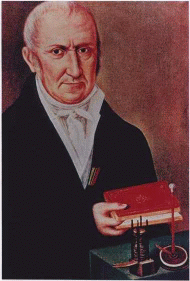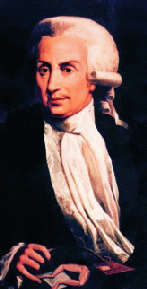Luigi Galvani (continued)
|
|
 |
|
| Fig. 5: Portrait of Luigi Galvani. | Fig. 6: Portrait of Alessandro Volta. |
Alessandro Volta, at the University of Pavia from 1778, was struck by Galvani's work and repeated his experiments. However, he soon reached quite a diverging interpretation: the contractions of the frog's muscles are not due to an animal electricity, but to the irritation of the nerves produced by the electric fluid (not of animal origin) put in motion by the bimetallic contact. The frog, in conclusion, was not a container of electricity, but only a detector.
A debate then began between the two scientist and their collaborators, which led to a deepened understanding on both sides. A short term product of paramount importance can be credited to Volta, who first discovered the contact potential and later invented the pile (1800).
A consequence of this success was that for quite a long time silence fell over those of Galvani's results that had to do with animal electricity. It should not be forgotten that he had shown, in 1794, that the contractions of the frog's muscles could take place using a monometallic arc, or even (1797) establishing a contact between the crural nerves and the muscles of the frog's legs. He later performed a final experiment (described in a letter to Lazzaro Spallanzani, and considered by the German physiologist Emil Du Bois Reymond as the basic experiment of electrophysiology), where contact was established only between the crural nerves of two frogs' thighs, thus also eliminating also the heterogeneity of the tissues.
It was in fact Du Boys Reymond, in 1848, who gave rise to a revival of Galvani's work, stating that animal electricity claimed, after half a century, the place that it deserved. In Italy, Galvanian studies were taken up again by, amongst others, Leopoldo Nobili and Carlo Matteucci.
In 1796, Napoleon's army occupied Bologna. Galvani refused to swear allegiance to the Cisalpine Republic. That cost him the loss of the positions he occupied at the University and the Institute of Science. He was reinstated as emeritus professor only after his death in 1798.
Check out the following website for a series of activities organised to celebrate the bicentenary of Galvani's death: http://www.bo.infn.it/galvani/.
Useful links
![]() Celebrations for the
bicentenary of Luigi Galvani's death:
The panels
of the Galvani-Volta exhibition,,Two hundred years young (W.Tega)
(in Italian)
Celebrations for the
bicentenary of Luigi Galvani's death:
The panels
of the Galvani-Volta exhibition,,Two hundred years young (W.Tega)
(in Italian)
|
|
(Luigi Galvani - page 4 of 4)
< Back | |
